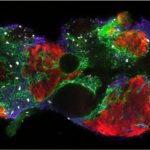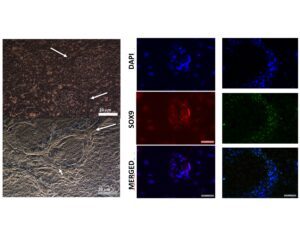About
A major gap in the field is the lack of appropriate cellular models to study human SD. This is particularly pressing since we are identifying differences between the human and mouse SD systems. We have established protocols to successfully derive Sertoli-like cells from human IPSCs (Figure 3).
Figure 3. Sertoli like cells derived from 46,XY iPSCs can aggregate to form tubular structures (left panel) which stain positive for SOX9 (middle panel). When the resultant population was FACS sorted and seeded on Matrigel, the SOX9+ cells aggregate and form tubules with lumen (right panel).
We are introducing pathogenic mutations associated with human sex reversal by CRISPR/Cas9 in human iPSCs that will be subjected to directed differentiation into somatic lineages of the gonad. The ability of the engineered cells to differentiate and form Sertoli-like cells will be studied to understand mechanism(s) of disease progression during embryonic gonad development in incidences of human sex-reversal. Using our current protocols we can get the Sertoli-like cells derived from the iPSCs to aggregate and form 3D tubular structures on matrigel. We are further developing this powerful tool to refine the recapitulation of tubular architecture and physiology.




